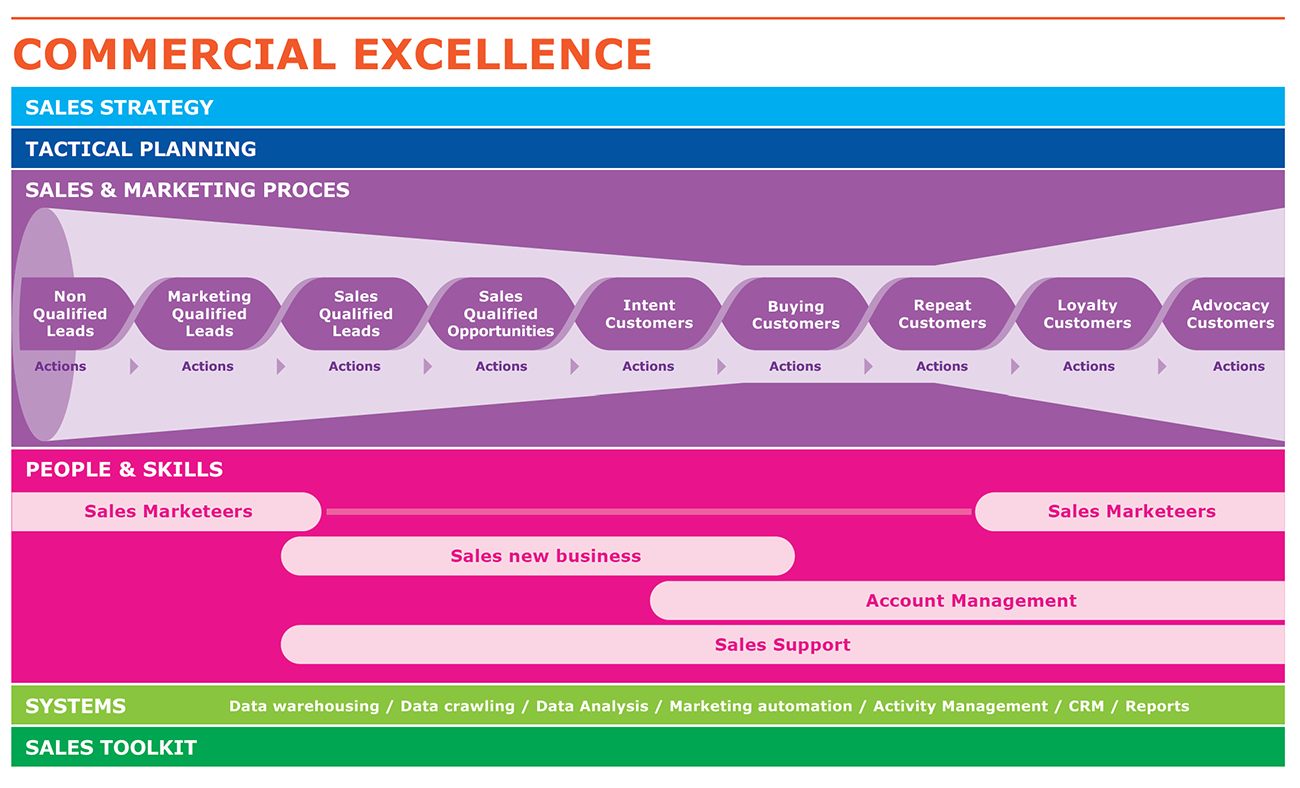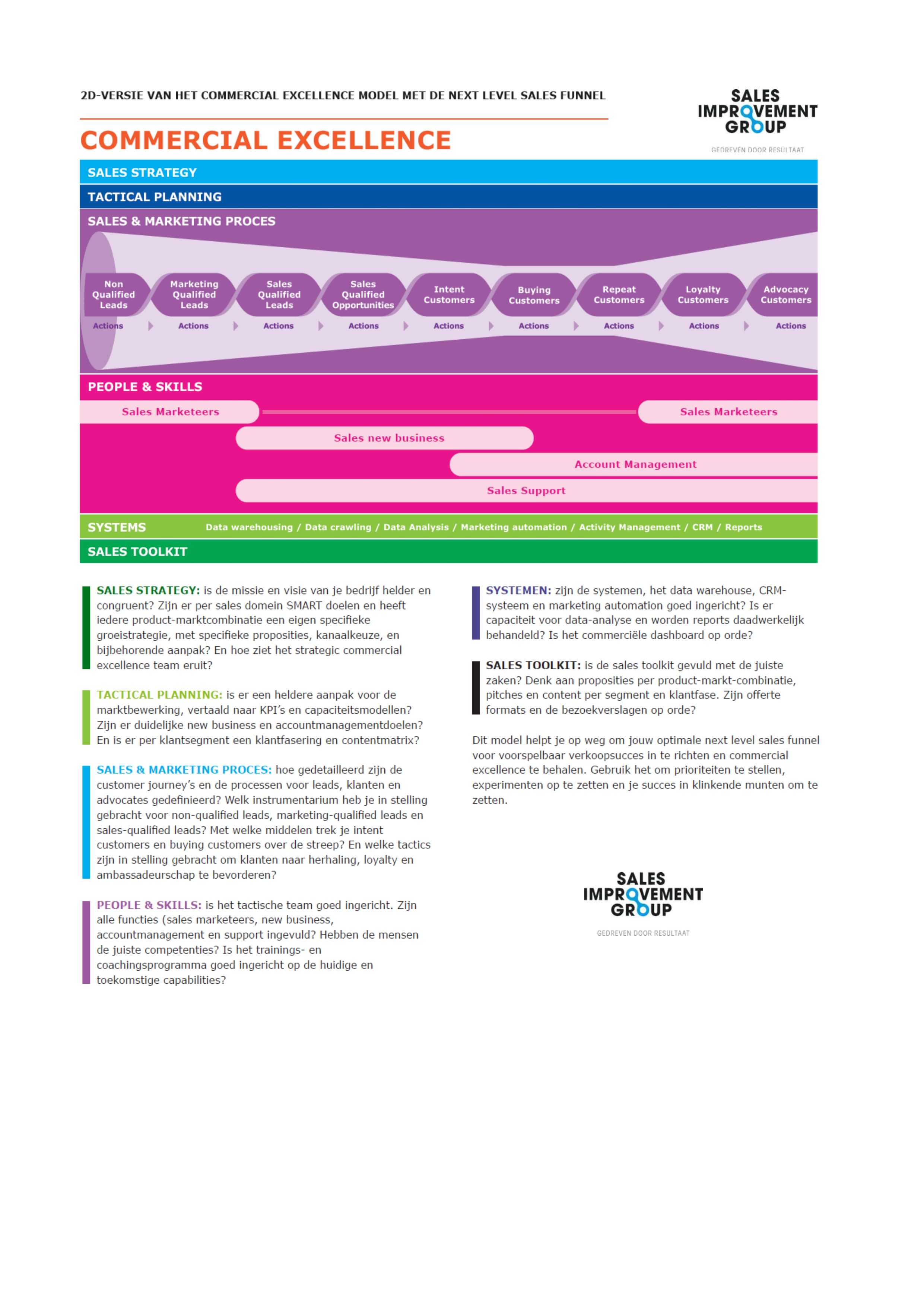Developing a Successful Next-Level Sales Funnel


Last update on: 1 Sept 2025
Reviewed by: ![]() Michel van Hesse
Michel van Hesse
For many companies, marketing and sales seem elusive. Directors often admit they don't precisely know what to 'put in' to get the desired 'results' out of it. Sales Improvement Group sees it differently. While sales and marketing aren't exact sciences, they are a numbers game. There is a clear relationship between what you 'put in' and what you 'get out' if marketing and sales work together purposefully and intricately. We help you get started with the next-level sales funnel.

Useful:
The foundation for commercial excellence is the next-level sales funnel. A sales funnel is the graphical representation of all the steps your ideal customer goes through, from completely unknown to a true ambassador. At each phase, the customer has different needs and specific information requirements. In each phase, marketing and sales must ensure precisely the right touchpoints, information, and temptations. So that the customer naturally ends up where you want them to be: an actively buying customer who actively shares with others how happy they are with you and/or your product.
Often, marketing and sales already work with funnels. But they are not always integrated, and almost always, they are too coarse. Subtlety reigns in the game of persuasion. That's why Sales Improvement Group developed the next-level sales funnel. In this funnel, we recognize a total of 9 individual steps: from completely unknown to ambassador. With these more finely defined small steps, you can better align with the behavior and beliefs of prospects and customers.

In the funnel, you integrate all the necessary activities, both from marketing and sales. Both disciplines reinforce each other and guide a prospect step by step towards becoming a customer. With the next-level sales funnel, you gain visibility into all the steps your customer actually takes and see at a glance where it 'leaks' and how you can improve it.
The next-level sales funnel is the beating heart of our commercial excellence model, which leads every organization to predictable success. Each step in the funnel is linked to strategy, activities, capacity, systems, planning, budget, and expected success. This allows you to see the cost and yield of optimizing each individual step. The effect is predictable by priority. You can then prioritize these choices, giving you a clear roadmap. So that you ultimately know exactly what goes into the funnel (input), what goes through it (throughput), and what comes out in terms of leads and sales (output). This makes your current and future sales funnel crystal clear and predictable at any given time.

This commercial excellence model enables you to monitor, steer, and predict the efforts of marketers, sales managers, account managers, and support. The model shows the coherence and status of all marketing and sales activities, such as:
It is important to check the coherence of each element. For example, a sales training has much less effect if there is no coaching, a CRM system does not adopt the sales concepts, and marketing does not adopt the sales methodology when developing products.
A sales funnel is the journey a customer takes from the initial contact to the actual purchase. Visually, the sales funnel is represented as a funnel. At the top, the sales funnel is wide because it attracts many people. As the journey progresses, more and more people drop off, making the funnel narrower. At the bottom, only those who actually make a purchase remain.
So, a sales funnel is a way to map and visualize the customer journey. The funnel is used by the marketing and sales departments to show the different parts of the sales process and to indicate in which part of the funnel a customer is. This makes it clear which steps need to be taken to turn a prospect into a customer.
Over the years, various theoretical approaches to sales funnels have been developed, resulting in different models. The exact content of the funnel may vary depending on the approach, but certain steps usually remain consistent. These steps can be divided into four different parts, which are the basis of every sales funnel, although the actual content may differ from one funnel to another.
The top part, which is about brand awareness, is about brand recognition. It's important to introduce as many people as possible to the brand.
Once many people have become familiar with the company and the brand, it's time to pique people's interest in the products or services. Not everyone will be interested in what your company has to offer, so some people will drop off here.
After getting some people interested in your product or service, these individuals need to consider whether they want to actually use what you're offering.
After consideration, you want people to move on to actually purchasing the product or service. This part is about selling the product and less about marketing.
Within these four parts, there are different steps that can be identified. These steps may vary slightly from one sales funnel to another but usually look something like this:
Generating leads and qualifying them is usually done by the marketing department, which then transfers potential customers to the sales department. They are the ones who ultimately close the deal.
With the above components, you have a good idea of which aspects should definitely not be missing from the sales funnel. However, the actual implementation will vary from one company and funnel to another.
When creating a sales funnel, it's important to involve not only the sales department but also the marketers. A successful funnel consists of both a marketing and a sales part. Good coordination between both parts is crucial for the funnel's success.
When you start creating the funnel, begin by defining the target audience. What does the ideal customer look like? What are their interests and problems? In what way can you provide a solution to this problem? Be specific and focus on one target audience.
Now that you know who you want to reach, it's time to consider what you want to achieve. Make the objectives clear. Is it about a certain number of sales per month, or do you want a certain number of people to schedule a conversation with you? When formulating these goals, also think about the cost per lead and the conversion rate.
Having clarified who you want to reach and what you want to achieve, it's time to actually get people into your sales funnel. This can be done in various ways, but a good method is by offering something 'free.' We put 'free' in quotation marks because it may not cost you money, but it can still be very valuable. In exchange for data such as a name and email address, you give something of value away. It could be an e-book, whitepaper, or even a free consultation. Your potential customer gets to know your offering, and you obtain data to contact them again later.
Aside from your free offering, you also have other (paid) products or services. It's good to have these listed for yourself. This way, you can easily determine the order in which you can offer your services or products to your potential customers.
The way a website is structured is crucial in a sales funnel. You need a page where you place the free offering, as well as a thank-you page when someone has ordered the offering. This is where you can make a One Time Offer. This offer is only valid at that moment. Or you can direct people to your social media channels.
After the free offering, you know that someone is interested in what your company has to offer, but this is often not immediately convertible into a sale. On average, customers need seven contact points before they make a purchase. That's why email marketing is a good idea following the free offering. This keeps a customer 'warm' and builds trust. After several emails, you can also promote and perhaps even sell your product here.
Sometimes, email is a good way to introduce a customer to your company, but you may still need a personal approach for the actual sale. Different sales strategies come in handy here. The implementation depends on the specific situation.

There are different sales funnel models and examples, with varying details but similar overall principles. The most important thing is to know your customer and understand what works and what doesn't. A good collaboration between marketing and sales is also crucial. Moreover, a funnel is not a static model that you can fill in repeatedly. A well-functioning sales funnel can work for a longer time but is always subject to changes in the market, product, and customers. Regularly reviewing the sales funnel is therefore highly recommended. Analyze which parts work well and where there is room for improvement.
A sales funnel always contains standard components but is still unique for each company. That's why a standard template is not always the best way to create a sales funnel. It's important to ensure that the funnel is technically well set up and that the content you offer is valuable. The implementation depends on the product or service you offer and the customer journey the customer goes through.
A sales funnel can be as simple or complex as you want it to be. A basic funnel is a good starting point but may not yield the best results. Still, having a strong foundation is half the battle. Therefore, don't start too complex, but make sure the funnel's foundation is solid. Afterward, you can gradually adjust, improve, and expand the funnel.
Below, you can find the commercial excellence and sales funnel template.

Do you find it challenging to visualize your sales funnel correctly or need help setting up the basic funnel? Or is the basic sales funnel already working well, but you're unsure how to expand it further? In such cases, it's wise to seek assistance from an expert. Sales Improvement Group offers various training programs, including the best sales training in the Netherlands. This can help you set up a solid marketing and sales funnel, attracting more and better leads and, most importantly, converting them into paying customers. It benefits the entire company.
A sales funnel is a strategy used to convert potential customers into paying customers through a series of marketing and sales actions. It is a visual model of the journey a prospect takes before becoming a customer. It is also referred to as a sales process, marketing funnel, or conversion funnel.
Creating an effective sales funnel requires a clear understanding of your customers' needs and the steps they take to decide on a purchase. Here are some steps you can take to create a sales funnel:
A typical sales funnel consists of several stages that potential customers go through before making a purchase. Below are the four most common stages in outline:
However, a sales funnel may look different for each business, depending on specific objectives and needs. Beneath these four main stages, there are various marketing and sales activities that you can visualize in your sales funnel.
By using a sales funnel, you gain more insight into your customers' buying behavior. You can see how many people drop out at each stage of the funnel and why they abandon the process. This allows you to optimize the funnel and increase conversion rates. Additionally, by analyzing the funnel, you can determine which content works best and which doesn't, allowing you to make improvements. In summary, a sales funnel is an essential part of a successful sales strategy and can contribute to improving your revenue and profitability.